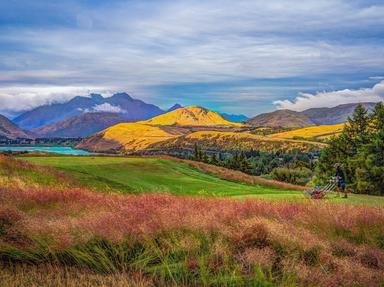Quiz Answer Key and Fun Facts
1. This region is located on North Island. Its long coastal area is lined by the Hakarimata Range. However, its black sand beaches are prime surfing spots. Hamilton is the dominant city here. Historically, this region was the location of a famous invasion in the 1860s that secured British domination of New Zealand. What region, the largest on North Island, is this?
2. This next region is the largest in New Zealand. Internationally, this region might be best known for the series of large, destructive earthquakes that tend to effect the area. The area is home to a some of New Zealand's best known ski resorts in the Southern Alps. Mount Cook (Aoraki), New Zealand's highest point (pictured) is located here. Christchurch is by far and away the largest city in this region. Some of the sites there include Cathedral Square and Hagley Park. What South Island region is this?
3. This region covers much of the north coast of North Island around a body of water of the same name. The most famous city here is Rotorua which is the home of many geysers, hot springs (pictured), hot mud pits and other thermal geological features. Mount Tarawera is located here. The world's once most powerful geyser Waimangu Geyser can also be found here. What hot region is this?
4. This region is named after a city. Although it contains much more than just the city of the same name, the city dominates the region. Some of the famous sites here include the Harbour Bridge (pictured), the War Memorial Museum, Sky Tower and Mount Eden. Which region is this?
5. This region on South Island is known for its many wineries and vineyards. Some of the major geographical features here are Kawarau Gorge (pictured) and Mount Aspring (Tititea). The region also had a famous gold rush in the 1860s. Dunedin is the principal city here and is home to New Zealand's oldest university. Dunedin is nicknamed the Edinburgh of the South because of its Scottish influence. What South Island region is this?
6. This region was named after the Maori name for the volcano that is the main geological feature in Egmont National Park (Dawson Falls pictured). This region is known for being the main energy production center for New Zealand because the Maui Gas Field is located off the coastline. The region is also well known for its dairy industry. Which region on North Island is this?
7. This region is the least populous in New Zealand. The Southern Alps run through here but the most famous feature is the Pancake Rocks at Punakaiki (pictured). Because of its long coastline, fishing and tourism are popular industries but there is also a strong mining economy as well. Which region is this?
8. This region is, unironically, the northernmost in New Zealand. It occupies most of peninsula of the same name. The region is heavily forested with long stretching beaches. There are many islands and bays (Parua Bay pictured) dotted around the region, including Spirits Bay which is where the Maori believe souls go to leave the Earth. What region is this?
9. This region on South Island contains New Zealand's largest national park: Fiordland National Park, home of the famous Milford Sound (Stirling Falls pictured). Doubtful Sound, which is home to an abundance of marine wildlife, can also be found here. Invercargill is the main city here. This region spans both South Island and Stewart Island. What region is this?
10. This district used to be called East Coast because it is the easternmost in New Zealand. The Maori call it Te Tai Rawhiti, which means Coast of the Sunrise because the sun rises first in the world here each day. The culture in this region is strongly influenced by the Maori and contains one of the largest populations of Maori people in New Zealand. What region is this?
Source: Author
Joepetz
This quiz was reviewed by FunTrivia editor
agony before going online.
Any errors found in FunTrivia content are routinely corrected through our feedback system.
